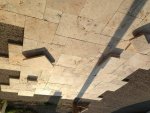I know I know, this topic has been discussed on the forum. Maybe I just haven't found the right thread yet, but so far as I can tell this has never deffinitively been answered. Same is true for an internet search; some say you can, more say you can't, and few if not any of the naysayers have actually tried it. So, the question is can we or can we not install travertine (or similar natural stone) in freezing climates and expect good outcomes? I propose a test.
The problem here is time. Obviously nobody wants to wait for a decade or two of natural weather exposure to get the results. So, we have to perform some kind of accelerated life cycle testing. I'm open for suggestions here but I'd like to throw out my suggestion and get some opinions.
Obtain a few samples of pavers (premium select grade)
Submerge pavers in water for some amount of time (2-24hrs?, TBD)
Place pavers in freezer overnight
Place pavers outside in direct sunlight all day
Rince, repeat...for some amount of time (60-90 days?, TBD)
Observe results
This assumes summer time, if winter time then reverse. Keep pavers outside overnight and bring indoors to thaw.
So the questions are, how many freeze/thaw cycles occur on average in a year. Of course we're talking about northern US snow belt. How do we know how many years of exposure we are simulating. And before you say, hey you know there's more to weathering effects than freezing and thawing, I know! There's wind and water erosion, UV effects, acid rain...etc. But we have to start somewhere, and the biggest point of contention are the freezing and thawing effects on porous stones.
Ok, what do you think?
The problem here is time. Obviously nobody wants to wait for a decade or two of natural weather exposure to get the results. So, we have to perform some kind of accelerated life cycle testing. I'm open for suggestions here but I'd like to throw out my suggestion and get some opinions.
Obtain a few samples of pavers (premium select grade)
Submerge pavers in water for some amount of time (2-24hrs?, TBD)
Place pavers in freezer overnight
Place pavers outside in direct sunlight all day
Rince, repeat...for some amount of time (60-90 days?, TBD)
Observe results
This assumes summer time, if winter time then reverse. Keep pavers outside overnight and bring indoors to thaw.
So the questions are, how many freeze/thaw cycles occur on average in a year. Of course we're talking about northern US snow belt. How do we know how many years of exposure we are simulating. And before you say, hey you know there's more to weathering effects than freezing and thawing, I know! There's wind and water erosion, UV effects, acid rain...etc. But we have to start somewhere, and the biggest point of contention are the freezing and thawing effects on porous stones.
Ok, what do you think?


